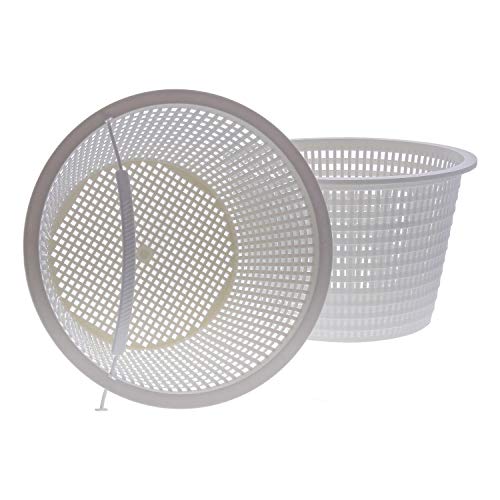Maybe you’ve lost your pool filter’s owner manual and want to check if the pressure readings are normal. Or perhaps you think the reading you’re getting is off and want to know how to correct it. Regardless of your filter type, we have you covered!
So what are normal pool filter pressure ranges?
The average pool filter pressure range is between 10-25 psi regardless of filter type. Factors such as pool pump size, filter size, and pipe diameter and length all influence your pool’s normal pressure range.
So, let’s dive in and see how you can find your pool filter’s normal pressure range. And how to fix it if the gauge is reading too high or low.
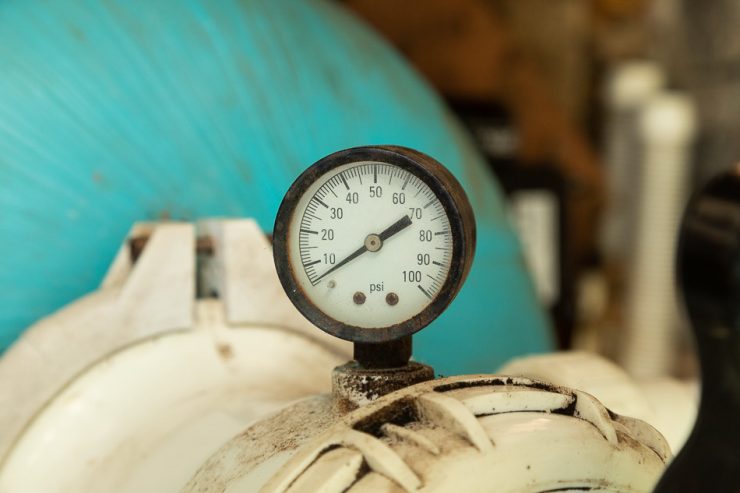
Article Contents
What is a Pool Filter Pressure Gauge?
A pool filter pressure gauge monitors the pressure within the filter tank. The gauge measures pressure in pounds per square inch (psi) and are responsible for letting you know if the pressure within goes too high or too low.
A pool filter gauge usually sits on the top of your filter and looks like a clock. The dial numbers (0 to 60) fan out from a central indicator on the gauge. This indicator will move to reflect the pressure, whether it’s normal, too high, or too low.
Although pools have a maximum psi of 30, having that extra 30 psi threshold will help to diagnose pressure spikes.
Interfering with the water flow, either decreasing or increasing, will cause the gauge reading to fluctuate as the pressure inside the tank changes. If your pressure gauge is reading outside of its normal range, you can expect multiple problems to pop up if left uncorrected.
Sand Filter Normal Pressure Range
The general pressure guideline for a sand filter is between 10-25 psi, but your average is subjective as long as it’s reading over 0 psi and under 30 psi. Unfortunately, there is no definite range your pressure gauge should be reading.
The ideal time to measure your filter’s normal pressure range is the reading you get after installing the filter. The perfect scenario is to do this when everything is new/clean (filter media), and the pump is working just as it should be.
However, you may not have recorded the psi reading when first installing the filter. Luckily, you can still get a normal baseline reading. The best time to take this reading is after backwashing your filter. And when you’re sure everything else is working perfectly.
As the filter gets dirty through normal use, the pressure goes up. When it’s higher by 7-10 psi, it’s time to backwash.
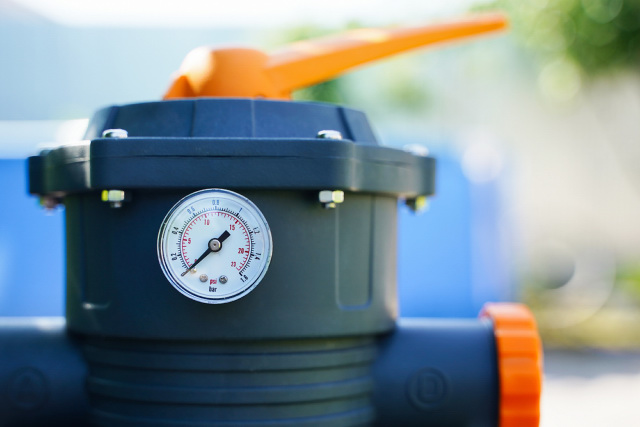
D.E. Filter Normal Pressure Range
The general guideline for a pressure reading of a DE filter gauge is between 10-25 psi, with a maximum of 30 psi. Your DE filter’s normal range depends on your setup but so long as the psi is above 0 and below the maximum, you’re safe.
The ideal time to record your DE filter pressure is when it’s new and being used for the first time. The pool equipment is new and working as it should be. The reading you get during this time is your filter’s normal pressure reading. And you can get its baseline range after its first backwash.
If you didn’t note the psi reading after installation, you can still get a baseline average reading (as long as everything else is working perfectly). Backwash the filter and ensure the skimmer baskets are clear, then take a reading with the filter running in “filter” mode.
If you’re getting a reading higher or lower than normal by 5-10 psi, it could be a sign that DE isn’t doing its job correctly or that the filter is dirty. Start by backwashing and recharging your DE filter. Here’s how, our guide, How to Recharge or Refill DE in Pool Filter, will help you refill DE quickly and safely.
Cartridge Filter Normal Pressure Range
Your pool cartridge filter’s normal pressure will depend on your setup (piping, filter size, etc.), but generally, it should be within a range of 10-25 psi. However, it mustn’t exceed a reading above 30 psi.
Again, the perfect time to get your baseline pressure reading is to record it after the first installation. Pool equipment is brand new, and the pump is working at peak performance. Once you know the baseline pressure, you can compare the pressure at any time to this figure to know if your filter is working properly or in need of a cleaning.
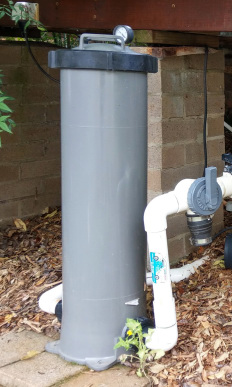
You may not have noted the pressure reading during the initial setup for many reasons. But you can still get baseline pressure. Just ensure that everything is working perfectly and, after cleaning the cartridge, take a note of the pressure. This will be your normal pressure.
If you notice the pressure changing by 7 psi, it could indicate that the cartridge isn’t working correctly. If this is the case, it’s time to either replace the cartridge or deep clean it.
Forking out for a new cartridge isn’t ideal, so following our guide, How to Clean Pool Cartridge Filter (Using Muriatic Acid), on deep cleaning a cartridge could be just what you need.
Causes of High Filter Pressure
If you’re getting a high filter pressure reading, let’s look at some common high filter pressure causes.
- A dirty filter
- The pump is too big
- Too much or too little filter media
- Blockage on the pressure side of the pump
You can find a complete list of possible causes in our guide: 8 Reasons Filter Pump Pressure is High (And How to Fix). But, first, let’s look at each of the above causes and how to fix them.
1. The Filter is Dirty
A dirty filter is one of the most common reasons for high pressure. And luckily, also one of the most straightforward fixes. A dirty or clogged filter prevents good water flow, which will cause pressure to build up.
To fix it: Simply, clean the filter as per the guidelines of the filter type. You can backwash DE and sand filters, whereas you’ll need to remove the cartridges and clean a cartridge filter by hand.
2. The Pump is Too Big
This will most likely be the cause if you notice a pressure rise after changing the pump. This is because filters have a maximum flow rate that a new powerful pump can exceed, causing pressure build-up.
To fix it: The best solution is to compare the pump’s flow rate and horsepower against the filter’s maximum flow rate.
If the pump is too large, you’ll need to replace it with a smaller one or change the filter. Choose the lower setting if you have a variable/two-speed pump.
3. Using Too Much Filter Media
This will only apply to sand or DE filters as cartridge filters. Adding too much media (or using the wrong grade) will cause high pressure.
To fix it: A simple fix is to remove some of the media and check the pressure reading. Or completely replace the media with suitable high-grade DE powder or eco-friendly sand media, which is a safer alternative to the traditional sand media. You can get these products here:
| Image | Product | Features | Link |
|---|---|---|---|
 | Robelle Diatomaceous Earth Powder
| 9.7 | Check Price |
 | Aitsite Eco-Friendly Filter Balls
| 9.5 | Check Price |
4. Blockage on the Pressure Side of Pump
The pressure side of the pump is located between the pump’s output side and the pool’s return jets. If there is a restriction here, it will cause high pressure.
Typical causes are a blocked or incorrectly working filter. This could be as simple as backwashing or cleaning the cartridge, or it could be a faulty multiport valve or broken laterals.
Other reasons can include debris caught in the lines. But this isn’t so common.
Causes of Low Filter Pressure
Again, there are many reasons that you’re getting a low-pressure reading. Some common causes are below.
- The skimmer basket or pump basket is clogged
- Multiport Valve is set to Waste
- The pool pump has lost prime
- Leak in the suction side of the pump
To find out more reasons why you’re getting low filter pressure, regardless of filter type, have a look at our guide, How To Fix Low or No Pressure In Pool Filter Quickly, on tips to fix it.
1. The Skimmer/Strainer Basket is Clogged
A clogged skimmer/strainer basket will reduce the water flow through the filter and cause a pressure drop. The typical culprits of clogging are dirt, debris, or leaves.
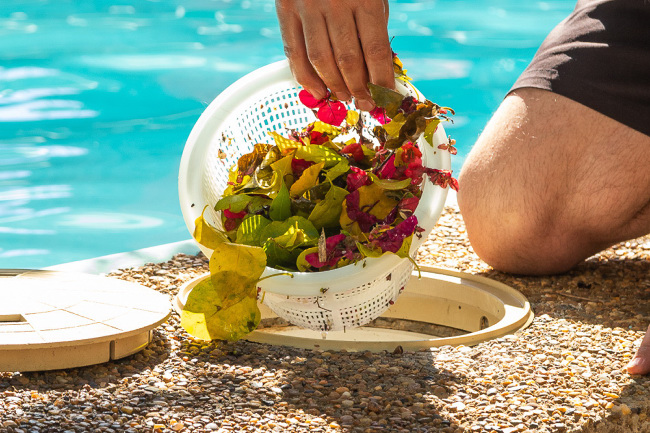
To fix it: To clear out the basket, first turn off the filter system and clean out the skimmer basket. And check for any damage on the basket and replace it if needed. Here’s a skimmer replacement basket we can recommend:
- Fits many pool skimmers
- Chlorine-resistant plastic mesh construction
Check the pump basket by switching off the power, then opening the pump lid. Remove the basket and empty it out.
2. The Multiport Valve is Set to Waste
If your multiport valve (MPV) is accidentally in the Waste position, there will be no filter pressure. This is because the water is bypassing the filter. By default, cartridge filters don’t have MPVs.
To fix it: Turn off the pump and move the MPV lever to the Filter. And let it circulate in the system before checking the pressure gauge.
3. The Pool Pump Has Lost Its Prime
A pool pump typically loses its prime after turning the pump back on. As a result, air can get trapped in the filter system or piping, meaning the pump can’t circulate water properly, resulting in low pressure.
To fix it: Check the pump lid for any air bubbles. If there are bubbles (or it’s not full of water), simply open the cover and fill it with water.
Also, check the pool’s water level isn’t low.
4. Suction Side Leak
Leaks between the skimmer and the pump cause low pressure. Typically, broken or cracked pipes cause leaks. Leaks occur from joins in the pipes and in the unions too.
Final Thoughts
Discovering that there aren’t any set psi ranges for each filter type might be frustrating. Luckily, finding your filter’s normal range is an easy process.
And, once you know your personal filter’s normal pressure range, many pool owners recommend marking it on the gauge with a permanent marker.
Or, if you have a pressure gauge with two indicators (green and red), you can set the normal pressure there.
Related Reading: How Much Sand to Put in a Sand Filter (How Far to Fill)

